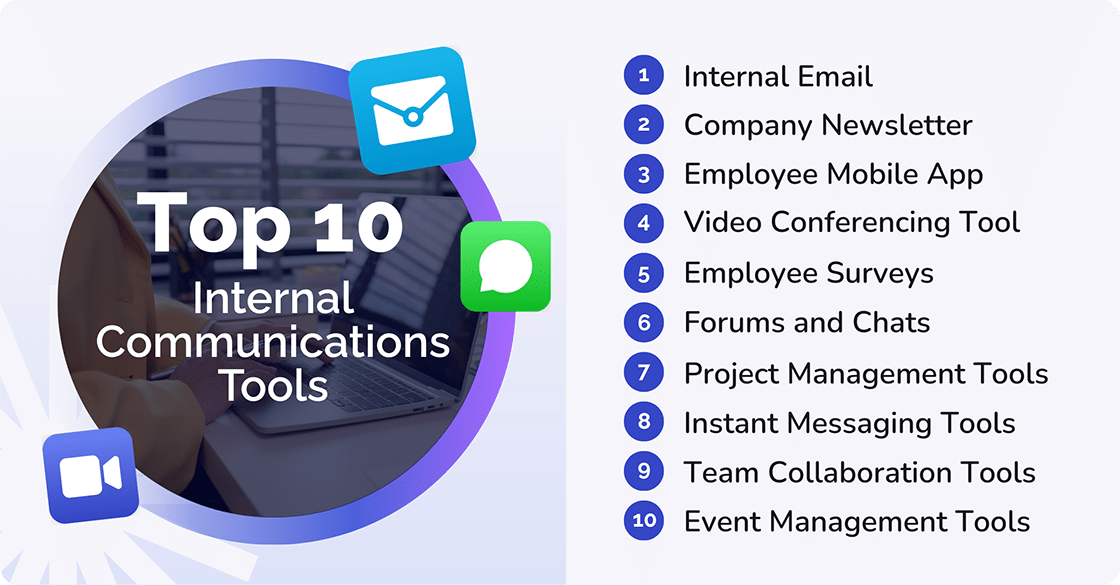Internal communication tools play a critical role in every business. Find out what your options are and which will work best for you.


Choosing the right internal communications software is a delicate process. Evaluate yourcommunication goals and needs, and select the right software with confidence using our Internal Communication Software Buyer’s Guide.
Access NowLeveraging the right internal communication tools plays a critical role in a company’s success. These tools not only streamline the flow of information but can also foster a positive corporate culture.
Recognizing the importance of improving internal communications, research documents continue to highlight the importance of internal communicators prioritizing communication tools. They also focus on the importance of identifying and then using the best employee communication tools to meet organizations’ needs.
For example, the Grammarly for Business 2024 State of Business Communication report, published in 2025, emphasizes that business success hinges on effective communications. However, it draws attention to the fact that the impact achieved will depend on how they enhance meaningful communication throughout the organization and equip employees with the right tools to communicate more effectively, not just more frequently.
Furthermore, the stats in the report show that an increasing number of knowledge workers (66% vs 58% the previous year) want better tools to enable them to be more effective in their roles. Even more business leaders (72%) responded, stating they wished they had better tools to improve the effectiveness of their internal communications.

One of the primary questions Gallagher’s State of the Sector Employee Communications Report 2025 considers is whether communicators are equipped with the right tools and technology to drive business impact.
In this post, we’re going to provide insights into the importance of tools used for internal communications. We’ll explain what internal communications tools are and why they are vital for effective internal communications. We will discuss the criteria needed to evaluate tools for internal communications. And finally, we’ll present our top 10 best internal communications tools for 2025. We’re going to briefly describe and evaluate these to help you make a well-informed decision that will suit your unique workplace needs.
Internal communications is a strategic business function that facilitates the exchange of information between those in any organization, from management to every employee. It is achieved by using a diverse variety of internal communication tools including instant messaging tools, internal communication software, and online collaboration tools. It’s all about creating open lines of communication within a business to ensure that everyone within it, from leaders to individual members of staff, remain connected.
Tools used to enhance internal communications comprise essential platforms and software that help convey messages within an organization. These employee communication tools play a pivotal role in ensuring efficient internal communications by allowing team members to share information, collaborate, and give feedback.
There is a broad spectrum of options available to meet a company’s specific needs including email, employee management apps, internal communication platforms, employee feedback apps, surveys, and analytical tools. There are also intranets, digital screens, employee social networks, and internal communication software that help companies manage employee communications and streamline communications within the organization.
Another benefit is that these tools can help reduce the need for face-to-face meetings, which ultimately saves time and money, and is a great help for remote workers. When employees want to open company messages as much as personal ones, that’s when you know you’ve done internal communications right.
Importantly, Artificial Intelligence (AI) is also ranking as a vital internal communications tool.
The 2025 Grammarly report focuses specifically on how Gen AI tools will transform workplace communication for those who are able to close knowledge gaps. At the same time, they advise organizations to identify AI technology that can be easily embedded into employees’ communication channels and existing workflows.
Gallagher’s State of the Sector report highlights that AI remains a largely untapped internal communications tool.
Developers of a project management tool, Project.co states that their research shows email remains the most widely used tool for client communication. Of those canvassed for their Communication Statistics 2025 report, 57% rated email the top tool for clients, while 36% said it was the most popular tool for internal communications. In terms of client comms, 15% use project management tools, 10% use online chat tools like Slack, 9% opt for phones, and a very small percentage (2%) opt for face-to-face contact.
For coworker comms, online chat tools are second-best after email (26%), followed by project management tools (17%). Both face-to-face and phone calls were ranked by 6%. Another category the report suggests organizations watch during 2025, falls under “other” (9%). Most cited Microsoft Teams, video calls, and WhatsApp.

It’s impossible to overstate the relevance of internal communication in the current corporate environment. Effective internal communications play a significant role in increasing employee engagement, morale, and productivity. They also help build a cohesive culture and enhance the overall efficiency of an organization.
At the same time, it’s important to recognize that internal communications is a term that isn’t limited to corporations and large businesses. Whether we’re talking about small businesses, non-profit organizations, communities, or governments, it is a critical element in ensuring smooth operations per se. Modern internal communication strategies including tools like employee management apps, employee feedback apps, and internal communication platforms, have revolutionized the way we handle internal communications, making them much more efficient, interactive, and productive.
A really good internal communications strategy can lead to enhanced employee engagement, better team collaboration, and effective internal communications throughout the organization. To optimize this, many businesses use a variety of employee communication tools including community channels, corporate and/or employee communication tools, and internal newsletters.
The fact is that internal communication tools facilitate effective workplace communication by establishing a seamless platform for sharing information, discussing ideas, and building relationships among team members. These tools fill the gap that might exist due to geographical distribution, different time zones, and varying workflows that we all encounter in most modern-day business operations.
The essence of internal communications lies not just in an interchange of words but in fostering a culture where every voice matters. Whether it’s a corporate communication tool, an employee SMS tool, or some kind of internal communication software, the primary aim is to promote an open dialogue between management and employees.
Social media currently plays a massive part in this by providing a community channel for interaction. This proves that effective internal communications don’t always need to be formal.
Internal communications can drive an organization’s success at multiple levels. For instance, by utilizing employee email software, a social employee advocacy tool, or an effective collaboration platform, you can empower your employees to share information freely. At the same time, they can be encouraged to work together towards achieving common goals.
Effective employee communications can lead to increased job satisfaction, thereby reducing turnover rates and recruiting costs. It contributes to employees feeling valued and appreciated, which can significantly improve their levels of engagement and productivity.

Choosing the right tools for internal communications is a crucial step for effective and successful internal communication strategies. The appropriate tools can foster open dialogue and transparency, improve productivity, and increase employee engagement. The best internal communication software needs to fit your organization’s unique needs so it can enhance overall communication.
However, finding the perfect internal communication solution from the myriad of options available can be a daunting task. That’s why we’ve outlined some critical criteria that can guide your decision-making process and ensure you choose the best internal communication and employee management app to fit your organizational needs.
Align software for productivity and engagement

There is no doubt that when employees feel connected and valued, they experience higher job satisfaction and are less likely to leave. But engagement isn't enough. Personalization also plays a key role in ensuring that communication resonates with employees on an individual level.
An effective internal communications strategy, paired with the right tools, ensures that every team member receives relevant updates, company goals, and critical information tailored to their role, preferences, and behavior. Personalized internal communications not only foster alignment across the organization but also create a sense of belonging by delivering messages that feel meaningful rather than generic.
Beyond engagement, personalized communication drives better collaboration, smarter decision-making, and improved customer satisfaction by ensuring employees have the information they need when they need it. AI-powered tools, dynamic segmentation, and automated content delivery allow organizations to fine-tune messaging, keeping employees informed without overwhelming them.
With access to advanced personalization capabilities, your company can gain a significant competitive advantage, ensuring employees stay connected, engaged, and aligned with business objectives.
For more insights, explore our white paper, The Importance of Internal Communication. It highlights the value of employee engagement, strategic communication tools, and best practices for maximizing productivity in today’s evolving workplace.
In today’s fast-paced world, organizations need intuitive and easy-to-use internal communication tools. A complex tool can put users off, resulting in low adoption rates, and ultimately defeating its purpose. Therefore, user-friendliness is a must-have feature to improve the uptake and effectiveness of your chosen internal communication tool.
Typically, a user-friendly internal communications platform has a clean, intuitive, and interactive interface. It should be easy to navigate and person-friendly for those with varied, and sometimes limited, technical skill sets. Some excellent examples of user-friendly communication tools include instant messaging tools, collaboration tools, and employee feedback apps.
Another vital criterion for choosing the best tools for your internal communications is their ability to seamlessly integrate with other existing systems in your organization. An excellent internal communication tool should not work in isolation but should serve as a unifier that brings together various other tools that your team is working with. It should integrate with social media, email tracking, email lists, and other digital tools to create a unified communication strategy.
For instance, if your organization already uses an email template builder or uses a specific distribution list management tool for internal communications, the best additional tools you can choose will integrate easily with these systems. This functionality will improve workflow and promote efficient data sharing and communication among team members. This, in turn, will boost employee engagement and productivity.
In an era where data breaches are commonplace security cannot be overstated. The communication tools you choose should be designed with excellent security features to protect sensitive internal information. Encryption, two-factor authentication, and advanced permissions are some security implementations worth considering.
Moreover, you should ensure that your provider is able to demonstrate a commitment to user safety through compliance with data protection regulations. An ideal internal communication tool should possess vital features like data encryption and secure file storage and transfer. These types of solutions provide peace of mind by ensuring that internal communications are not an easy target for cyberattacks.
Ultimately, the process of choosing a suitable internal communication tool requires a keen, well-practiced, and educated eye that will identify important specifics. Always focus on the unique needs of your organization coupled with the tool’s ability to meet these needs adequately. User-friendliness, integration capabilities, and security are not just buzzwords. They are crucial factors that will determine the overall effectiveness of your internal communications strategy. Don’t ignore them.
The true impact of internal communications goes beyond message delivery. It lies in understanding how employees engage with content and using data to refine communication strategies. Engagement analytics capabilities provide valuable insights into what resonates with employees, which channels are most effective, and how messaging influences behavior and alignment with company goals.
With advanced internal communication tools, organizations can track open rates, click-through rates, content preferences, and employee feedback, ensuring communication efforts are both data-driven and continuously optimized. These insights can help internal communicators:
By leveraging engagement analytics, businesses can move beyond assumptions and make informed decisions that foster a more connected, engaged, and high-performing workforce.
Align software for productivity and engagement

Effective internal communications are the backbone of a well-functioning organization. With the help of the best internal communication tools, businesses can assure smooth coordination among team members and increase employee engagement.
Here are the top 10 tools we suggest using for your internal communication strategy. We’re going to briefly explain what each one is and then outline its benefits.
There is no doubt that one of the most common internal communication tools is internal email. This corporate communication tool connects employees within an organization using the company’s private email server. Distribution lists make it easy to send tailored messages to specific units or the entire workforce.
Internal email serves as a secure channel for sharing company bulletins, policy updates, or even surveys. This internal communication tool provides clear communication, file-sharing options, and email tracking, and can even be customized using an email template builder. The best platform will enable you to segment your employee audience so that the right people get the right message.
A company newsletter is an internal communication tool that organizations use to keep employees informed about company news, changes in the organization, updates to programs and initiatives, recognition, and so on. It is easy to create a wide variety of newsletter types and styles using a reliable template builder. Once complete, employee newsletters are often distributed via email lists in a digital format. Some companies still print newsletters in-house.
Company newsletters can be used successfully to encourage employer-employee communication and foster a sense of community within an organization. Moreover, they can be used as a vehicle for employee recognition, making them an excellent tool for boosting morale and engagement. They are also a valuable asset for holiday messaging.
A mobile employee communication app is a platform that’s designed specifically to streamline workforce communication. These employee communication tools provide an array of features including instant messaging, and the ability to share documents, schedules, and surveys. When you opt for an employee mobile app, you can usually base your choice on which features you need.
Access to an employee management app facilitates real-time updates, promotes engagement, and offers amazing ease of being able to communicate on the go. As a result, team members can stay connected and informed, enhancing collaboration and productivity. It’s also an invaluable tool for organizations with remote workers.
A video conferencing tool is a specialized type of software used for internal communications. software that enables face-to-face communication over the Internet. These tools often include features such as screen sharing, live chats, and recording capabilities. There are a huge number of options available to suit every type and size of organization.
Video conferencing increases the effectiveness of communication. It also helps to foster a strong collaborative environment. Video conferencing also saves time and resources on what used to be essential travel. It helps remote teams feel more connected and engaged with colleagues and management because they can see and identify with each other irrespective of where they are geographically.
Employee surveys are essentially online questionnaires that look for feedback from employees about various workplace-related issues. With the help of employee feedback apps, organizations can circulate employee surveys easily. They can also use analytics to measure feedback.
Employee surveys can be incredibly beneficial for internal communications. They provide insight into employee satisfaction, pinpoint areas for improvement, and offer an invaluable channel for anonymous feedback when this is the preferred option.
Forums and chats form an integral part of employee communication software and serve as internal communication platforms. They provide an open platform for employees to share knowledge, have informal conversations, and discuss projects in a relatively informal environment.
Forums and chats promote a culture of transparency and collaboration and can be an excellent source of innovation and problem-solving in an organization. They can reduce email clutter and provide for faster, more efficient communication.
A project management tool is an online collaboration tool that helps teams plan, organize, and manage their work. This platform type commonly offers the ability to assign tasks, track progress, share documents, and collaborate efficiently.
Project management tools help maintain transparency, ensuring effective internal communications, and providing a clear view of project timelines and responsibilities. These tools significantly improve productivity and efficiency in a team.
An instant messaging (IM) tool is an application or type of software that enables real-time communication through text-based messages. IM forms a crucial part of the internal communications strategy by providing a quick and efficient mode of communication.
IM tools ensure communication is fast, convenient, and reliable. They can significantly speed up decision-making, ensure fast resolution of queries, and even foster a sense of community and better relationships among team members.
A team collaboration tool is an application or platform that is designed to facilitate team interaction and work. Whether it’s sharing documents, scheduling meetings, or carrying out brainstorming sessions, these apps are multifunctional.
Collaboration tools promote team unity, improve productivity, and facilitate effective internal communications. They can help keep track of conversations, provide a historical record, and ensure everyone is on the same page.
An event management tool is a platform designed to assist in the organization and execution of corporate events. They aid in tasks such as registration, ticketing, and attendee tracking, among others. While they are designed for organizations that plan, organize, and run events, these tools can also be used for smaller internal organization events.
Event management tools offer numerous benefits such as easy organization, oversight of event progress, automated processes, and, most importantly, they help to ensure a successful event.

Writing for Forbes, Angela Ivey, director of corporate communications at Insperity, says that when teams have spent effort and valuable time on communication tools and other resources, it’s important to assess the results. You need to confirm successful initiatives and identify any areas that were weak and haven’t been performing well. You also need to pursue any opportunities that emerge that will increase all-important employee engagement.
There are various reasons why this is so important. Measuring success:
Check out our FREE ROI Calculator for Internal Communications to simplify measuring and assessing your communication tools.
Cerkl Broadcast is user-friendly, reassuringly secure, and designed for seamless integration with other communication systems — and more than just an internal communication tool. It’s a comprehensive, user-friendly, and secure platform designed to transform the way organizations connect with employees. With its seamless integration into existing communication systems, Broadcast ensures that important messages reach the right people, at the right time, through the right channels.
The platform’s powerful capabilities offer a suite of dynamic tools, including:
No matter the size or structure of your workforce — whether your employees are primarily on-site, fully remote, or spread across multiple locations — Cerkl Broadcast offers you the flexibility and scalability to take your internal communication strategy to the next level.

Align software for productivity and engagement
What are internal communication tools? These are tools that help streamline communication, enhance collaboration, and ensure that information flows effectively within the organization.
What are the 4 tools of communication? Writing, speaking, listening, and non-verbal communication are generally considered to be the four tools of communication. Whether used individually or together, they form the basis of how we exchange information and ideas in various contexts.
What is the most effective communication tool? We use so many communication tools, it’s impossible to highlight the one that is most effective. It depends on specific situations, the preferences of those involved, and the intended outcome of communication. However, email is undoubtedly the most common of all the internal communication tools, and employee apps are the most effective, especially for remote workers. In most cases, organizations opt to use a combination of tools.
What is the most widely used internal communication system? Email, Intranet, messaging apps, and collaboration software of various types usually feature in an inteEmail is undoubtedly the most widely internal comms tool used today. Other popular tools include intranet, messaging apps, and collaboration software of various types. But there are a myriad of options available and tools like Microsoft Teams, video calls, and WhatsApp appear to be gaining traction.

Align software for productivity and engagement